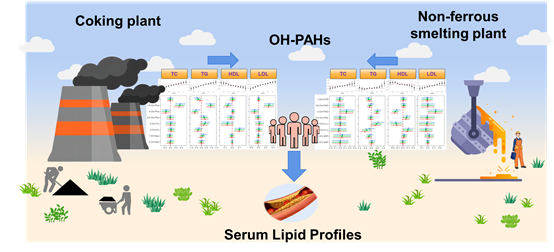近日,广东工业大学环境健康与污染控制研究院、环境科学与工程学院安太成教授团队在焦化和有色金属冶炼行业工人中多种羟基多环芳烃与血清脂质水平的关联研究中取得最新研究进展,研究成果以《Associations of multiple hydroxy-polycyclic aromatic hydrocarbons with serum levels of lipids in the workers from coking and non-ferrous smelting industries (https://doi.org/10.1016/j.jhazmat.2024.134664)》为题发表在Journal of Hazardous Materials (2024, 473: 134664)期刊上,通讯作者为安太成教授和华中科技大学的沈先涛教授。
这项研究以多变量线性回归、贝叶斯核机回归和分位数g计算,对焦化和有色金属冶炼行业工人中多种尿羟基化多环芳烃(OH-PAHs)与血清脂质水平进行数据建模,在不同场地对比中探讨了OH-PAHs与血清脂质的暴露-响应关系。这一研究对比了特殊工业场景下受到多环芳烃暴露的人类群体对于毒害化合物带来的健康影响。

论文网址:https://doi.org/10.1016/j.jhazmat.2024.134664
流行病学证据表明,接触多环芳烃(PAHs)与某些代谢疾病有关。然而,暴露受试者的多环芳烃与血清脂质谱之间的关系仍然未知。本文系统研究了焦化和有色冶炼行业工人中多种尿羟基化多环芳烃(OH-PAHs)与血清脂质水平的关联。采用多变量线性回归、贝叶斯核机回归和分位数g计算。发现在这两个行业的工人中,OH-PAH暴露与血清总胆固醇、总甘油三酯和低密度脂蛋白水平升高以及高密度脂蛋白水平降低有关。具体而言,有色冶炼工人尿4-羟基菲与血清总胆固醇、总甘油三酯和低密度脂蛋白水平呈显著正相关;然而,在焦化工人中观察到4-羟基菲与这些脂质水平的完全相反的关联。这项开创性的检查结果表明:暴露于OH-PAHs可能导致焦化和有色金属冶炼工人的血脂异常,并观察到不同的变化模式。这可能需要开展更大样本量的进一步前瞻性研究来验证这些发现。
图文摘要

英文摘要
Epidemiological evidence indicates that exposure to polycyclic aromatic hydrocarbons (PAHs) is associated with certain metabolic diseases. However, the relationship between PAHs and serum lipid profiles in exposed subjects remain unknown. Herein, the associations of multiple (8) urinary hydroxylated PAHs (OH-PAHs) in workers of coking (n = 655) and non-ferrous smelting (n = 614) industries with serum lipid levels (marking lipid metabolism) were examined. Multivariable linear regression, Bayesian kernel machine regression, and quantile g-computation were used. Most urinary OH-PAHs were significantly higher (p < 0.001) in coking workers than in non-ferrous smelting workers. In workers of both industries, OH-PAH exposure was associated with elevated levels of serum total cholesterol, total triglyceride, and low-density lipoprotein, as well as reduced high-density lipoprotein levels. Specifically, urinary 4-hydroxyphenanthrene was significantly positively associated with serum total cholesterol, total triglyceride, and low-density lipoprotein levels in non-ferrous smelting workers; however, the completely opposite association of 4-hydroxyphenanthrene with these lipid levels was observed in coking workers. The results of this pioneering examination suggest that exposure to OH-PAHs may contribute to dyslipidemia in coking and non-ferrous smelting workers, and distinct patterns of change were observed. Further prospective studies involving larger sample sizes are needed to further validate the findings.